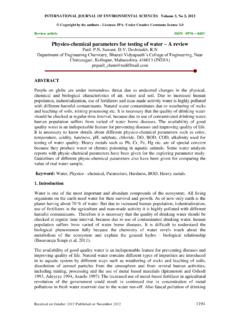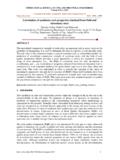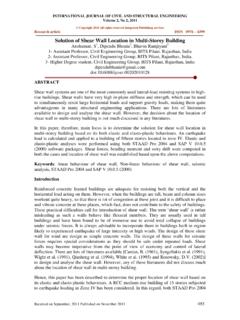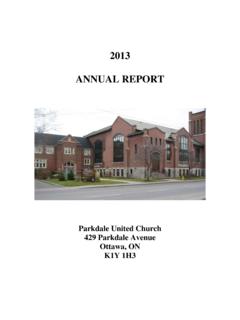Transcription of Title of the Research Work Should be written in …
1 Title of the Research work Should be writtenin This Style and Font Author Name 1, Author Name 2 , Author Name 3 ABSTRACT The abstract serves two major purposes: it helps a person decide whether to read the paper, and it provides the reader with a framework for understanding the paper if they decide to read it. Thus, abstract Should describe the most important aspects of the study within the word limit provided by the journal. As appropriate for Research , try to include a statement of the problem, the sample you studied, the dependent and independent variables, the instruments, the design, major findings, and conclusions. If pressed for space, concentrate on the problem and, especially, findings. A Research paper abstract is very similar to other parts of a Research paper, such as an introduction. An introduction also tells readers more about what they are going to learn from the Research paper.
2 However, the difference between introductions and Research paper abstracts is that introductions provide background information and introduce the topic of the Research paper. Abstracts give a general overview of the paper, but may not include any background information. Keywords: Author Guidelines, Research Paper Template, AJMR, IPA, Template 1. Introduction Start your report with a paragraph or two presenting the investigated problem, the importance of the study, and an overview of Research strategy. The introductory paragraphs are usually followed by a review of the literature. Show how Research builds on prior knowledge by presenting and evaluating what is already known about Research problem. Assume that the readers possess a broad knowledge of the field, but not the cited articles, books and papers. Discuss the findings of works that are pertinent to specific issue.
3 Usually will not need to elaborate on methods. The goal of the introduction and literature review is to demonstrate "the logical continuity between previous and present works" (APA, 1994). This does not mean need to provide an exhaustive historical review. Analyze the relationships among the related studies instead of presenting a series of seemingly unrelated abstracts or annotations. The introduction Should motivate the study. The reader Should understand why the problem was researched and why the studyrepresents a contribution to existing knowledge. Use font style Times Ne Roman, font size 12 with line spacing Journal of Management Research , , , 2010 2 2. Review of Literature/Theatrical Background of the Study A literature review is a body of text that aims to review the critical points of current knowledge including substantive findings as well as theoretical and methodological contributions to a particular topic.
4 Literature reviews are secondary sources, and as such, do not report any new or original experimental work . Most often associated with academic oriented literature, such as theses, a literature review usually precedes a Research proposal and results section. Its ultimate goal is to bring the reader up to date with current literature on a topic and forms the basis for another goal, such as future Research that may be needed in the area. A well structured literature review is characterized by a logical flow of ideas current and relevant references with consistent, appropriate referencing style proper use ofterminology and an unbiased and comprehensive view of the previous Research on the topic. 3. Research Objectives/ Research Questions/Hypotheses To Develop a template for publishing work in AJMR To find out the font size, font style and line spacing in order to write article/case study/ Research paper according to AJMR format.
5 To formulate the guidelines for AJMR authors 4. Research Methodology The method section includes separate descriptions of the sample, the materials, and the procedures, If needed. Describe sample with sufficient detail so that it is clear what population(s) the sample represents. A discussion of how the sample was formed is needed for reliability and understanding your study. The APA Task Force on Statistical Inference points out "how a population is defined affects almost every conclusion about an article" (Wilkinson, et al., 1999).. A description of instruments, including all surveys, tests, questionnaires, interview forms, and other tools used to provide data, Should appear. Evidence of reliability and validity Should be presented. Since reliability is a property of scores from a specific use of a specific instrument for a specific population, provide reliability estimates based on data.
6 The design of the study, whether it is a case study, a survey, a controlled experiment, a meta analysis, or some other type of Research , is conveyed through the procedures subsection. It is here that the activities of the researcher are described, such as what was said to the participants, how groups were formed, what control mechanisms were employed, etc. The description is sufficient if enough detail is present for the reader to replicate the essential elements of the study. It is important for the procedures to conform to ethical criteria for researchers (APA, 1992). 5. Analysis and Interpretation Present a summary of what found in analysis. Describe the techniques that used in each analysis and the results of each analysis. Start with a description of any complications, such as protocol violations and missing data that may have occurred.
7 Examine data for anomalies, such as outliers, points of high influence, miscoded data, and illogical Journal of Management Research , , , 2010 3 Use common sense to evaluate the quality of data and make adjustments. Describe the process that used in order to assure readers that editing was appropriate and purified rather than skewed results. With today s availability of statistical packages, it is fairly easy to use very sophisticated techniques to analyze data. Understand the techniques are used and the statistics that are reported. Try to use the simplest, appropriate technique for which can meet the underlying assumptions. If using inferential statistics, determine the power a priori based on anticipated distribution, design, and definition of practical significance. This information must stem from related literature and not the data that collected.
8 If fail to reach statistical significance, then this analysis can be used to show that the finding does not stem from low power. Where appropriate, compute and report effect sizes or, at a minimum, be sure to provide enough information so effect sizes can be computed. Effect sizes provide a common metric for evaluating results across studies and aid in the design of future studies. They will be needed by anyone who attempts a quantitative synthesis of study along with the others in given area of Research . For most Research reports, the results Should provide the summary details about what found rather than an exhaustive listing of every possible analysis and every data point. Use carefully planned tables and graphs. While tables and graphs Should be self explanatory, do not include a table or graph unless it is discussed in the report.
9 Limit them to those that help the reader understand data as they relate to the investigated problem Table 1: Use Font Size 12, Times New Roman don t Bold the Heading Keep it in Centre (Source: Specify Source of Table) Table Heading Table Font Font Style Times New Roman Font Size 12 Line Spacing Single and Justify Top /Bottom Margin 1 Right/Left Margin .75 Figure 1: Use Font Size 12, Times New Roman don t Bold the Heading Keep it in Centre (Source: Specify Source of Figure)Asian Journal of Management Research , , , 2010 4 6. Recommendation/Suggestion/Findings Font size Should be 12 Font Style Should be Times New Roman Single Line spacing Should be used Align Justify 7. Limitationof the Study Abstract details: The Abstract Should be a minimum of 200 and no more than 500 words including keywords.
10 Abstracts have to include the proposed Title for the paper, the full names of allthe authors. Full paper: Should not to be more than 9,000 words including abstract, keywords and references. 8. Conclusions At this point, the expert data set gives anauthority on the problemto address. In this section, discuss and interpret data for the reader,. Do not be afraid to state opinions. Many authors chose to begin the discussion section by highlighting key results. Return to the specific problem you investigated and tell the reader what now you think and why. Relate your findings to those of previous studies, by explaining relationships and supporting or disagreeing with what others have found. Describe your logic and draw your conclusions. Be careful, however, not to over generalize your results. Your conclusions Should be warranted by your study and your data.















